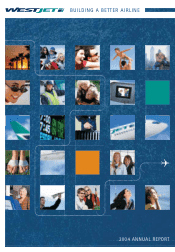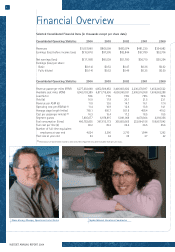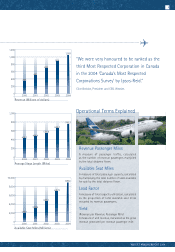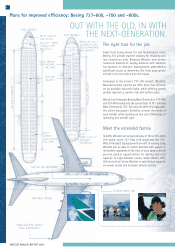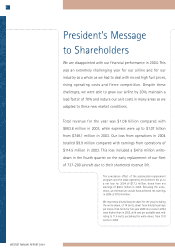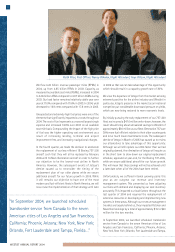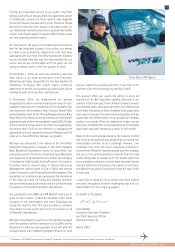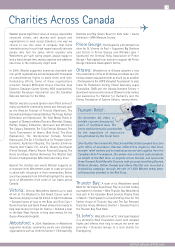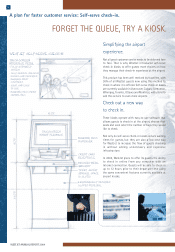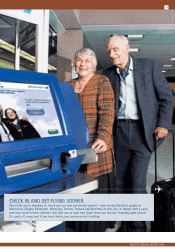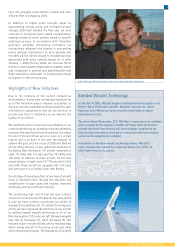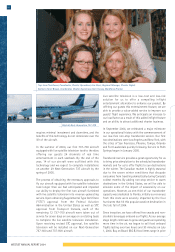Westjet 2004 Annual Report Download - page 10
Download and view the complete annual report
Please find page 10 of the 2004 Westjet annual report below. You can navigate through the pages in the report by either clicking on the pages listed below, or by using the keyword search tool below to find specific information within the annual report.
WESTJET ANNUAL REPORT 2004
10
“In September 2004, we launched scheduled
transborder service from Canada to the seven
American cities of Los Angeles and San Francisco,
California; Phoenix, Arizona; New York, New York;
Orlando, Fort Lauderdale and Tampa, Florida…”
Keith Price, First Officer; Nancy Whalen, Flight Attendant; Faye Wilson, Flight Attendant
We flew 6.28 billion revenue passenger miles (RPMs) in
2004, up from 4.85 billion RPMs in 2003. Capacity, as
measured by available seat miles (ASMs), increased in 2004
to 8.96 billion ASMs compared to 6.87 billion ASMs during
2003. Our load factor remained relatively stable year over
year at 70.0% compared with 70.6% in 2003. In 2004, yield
decreased to 16.9 cents compared with 17.8 cents in 2003.
Unexpected and extremely high fuel prices were one of the
elements that significantly impacted our costs throughout
2004. The cost of fuel represents our second largest single
expense and increased 18.9% over 2003 on an available
seat mile basis. Compounding the impact of the high price
of fuel was the higher operating cost environment as a
result of increasing landing, terminal and airport
improvement fees, and increasing navigational charges.
In the fourth quarter, we made the decision to accelerate
the replacement of our less-efficient 18 Boeing 737-200
aircraft such that they will all be replaced by February
2006 with 16 Next-Generation aircraft in order to further
our objective to be the lowest-cost airline in North
America. However, the subsequent events of Jetsgo’s
demise caused us to reconsider the timing of the
replacement plan of our older planes while we secure
additional aircraft for our future growth in 2006. While
it still remains our objective to have one of the most
modern and fuel-efficient fleets in North America, we will
now revise the implementation of that strategy until later
in 2006 so that we can take advantage of this opportunity
which should result in a capacity growth rate of 30%.
We view the departure of Jetsgo from the market as being
extremely positive for the airline industry and WestJet in
particular. Jetsgo’s presence in the market as an irrational
competitor put considerable downward pressure on yields,
which are now being restored to more economic levels.
By initially pursuing the early replacement of our 737-200
fleet, we incurred a $47.6 million write-down; however, the
result should bring about annualized savings to WestJet of
approximately $30 million as our Next-Generation 737s are
30% more fuel efficient relative to their older counterparts
and incur much lower maintenance costs. The subsequent
demise of Jetsgo in March of 2005 has caused us to review
our alternatives to take advantage of this opportunity.
Although we will still replace our 200s faster than we had
originally planned, the elimination of Jetsgo will require us
in the short term to slow down our original replacement
schedule, approved at year-end, for the Boeing 737-200s,
while we secure additional aircraft for our future growth.
This will mean that these savings will not be achieved until
a later date when all of the 200s have been retired.
Unfortunately, we suffered internal growing pains this
year as we outgrew our revenue and inventory
management system. This prevented us from adjusting
our fares with demand and displaying our seat inventory
accurately. This impacted our load factors throughout the
last quarter of 2004 and required the redeployment of
extensive resources in developing and implementing new
systems in these areas. Although our revenue management
troubles are largely behind us, they impacted October and
November bookings by a total of approximately $15 to $20
million for the two months.
In September 2004, we launched scheduled transborder
service from Canada to the seven American cities of Los
Angeles and San Francisco, California; Phoenix, Arizona;
New York, New York; Orlando, Fort Lauderdale and Tampa,

